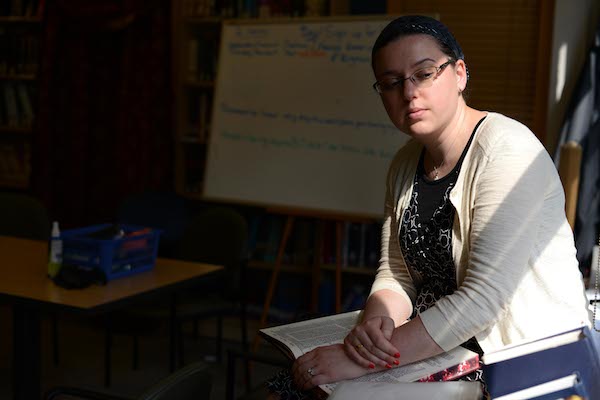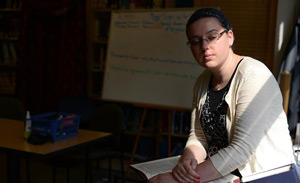A resolution issued last week by the Rabbinical Council of America (RCA), the largest association of Orthodox rabbis, bans its members from employing women clergy in their synagogues. The ban itself contains little that is new. Following upon a slew of earlier such statements, it expands a longstanding ban on the ordination of women as rabbis, prohibiting their employment by RCA members while pointedly endorsing women’s advancement in other religious capacities. Still, though the resolution could hardly have come as a surprise, reactions from the more liberal sectors within Orthodoxy have ranged from disappointment to outrage; among non-Orthodox and secular commentators, responses have tended to divide between, and sometimes to combine, the gleefully sarcastic and the unrestrainedly virulent.
Much of what has been written about the resolution in Orthodox circles focuses on how a grassroots group within the RCA was able to secure a hasty membership vote in favor of the ban, and on the document’s brusque tone, which is indeed so lacking in nuance that even the RCA’s leadership has attempted to walk it back. (Might including a woman among its authors have helped to temper the document with that certain feminine je ne sais quoi?) But more interesting than any of this is the fact that passing such a policy resolution was deemed necessary in the first place.
In that respect, last week’s uproar offers another occasion, far from the first in recent years, to assess the condition and future prospects of, in particular, Modern Orthodoxy: the centrist movement within the variegated universe of Orthodoxy that has always prided itself (in the words of the historian Jack Wertheimer) on its “successful integration of traditional religious behavior and belief with full participation in modern society.” More specifically, both the resolution and the ire surrounding it mark but one skirmish in a wider battle taking place between the Modern Orthodox establishment, led nominally by the RCA, and a vocal left-wing minority known as Open Orthodoxy.
Spearheaded by Rabbi Avi Weiss, who created his own institutional standard-bearers, Open Orthodoxy accuses the Modern Orthodox establishment of being out of touch with the challenges facing modern Jews. Its spokesmen claim that they represent the true Modern Orthodoxy, while the larger movement has come to represent (as one Open Orthodox rabbi puts it) an “ossified and unimaginative type of Judaism, always looking fearfully over its right shoulder.” Forging ahead despite occasional pushback from the RCA, Open Orthodoxy now boasts a men’s rabbinical-ordination program at Yeshivat Chovevei Torah and another program, at Yeshivat Maharat, which openly ordains women.
The charge that the establishment lacks even a healthy amount of dynamism is undeniably correct. Indeed, the RCA’s long failure to have clearly articulated the reasons behind a rabbinical norm that has held for over 2,000 years is but one sign of a broader disinclination to anticipate the challenges facing the movement and of an infrastructure ill-equipped to approach them properly as they arise. Without compromising its own position on the matter, the RCA could have sought to guide its constituency toward examining, from a traditional perspective, the religious, cultural, and social implications of women’s roles within Orthodoxy. Instead, after watching the women’s-ordination controversy brew within the organization’s walls for over six years, it seems that the majority of RCA members simply felt forced to pick a side. As a quick survey of the organization’s press releases in recent years shows, this passive posture, reflecting an essentially reactive stance toward critical issues and events, is habitual.
Lack of initiative is compounded by the frustrations inherent in an age of faltering clerical authority, a circumstance hardly unique to American Orthodoxy, or to Judaism. In Modern Orthodoxy’s case, this ebbing of clerical influence has been exacerbated by years of internecine skirmishes and rabbinical scandals. Moreover, although Modern Orthodoxy has produced many brilliant and dedicated leaders and laymen, it has yet to cultivate younger figures possessing the authority and broad appeal of its founding fathers. That earlier leadership, whose emblematic presence on the American scene was Rabbi Joseph B. Soloveitchik (1903-1993), embodied the ideal of the halakhic Jew in full engagement with the surrounding world.
In the absence of such figures, negotiating the contest between traditionalism and secular modernity requires a strategy. But there is no specific Modern Orthodox credo, no statement of Jewish values, no formalized rubric through which adherents are encouraged to think about issues other than those related to ritual practice. The movement grounds itself, properly, in the halakhic tradition, which, while well equipped with majority and minority views, arguments, loopholes, and exceptions, features no centralized authority and few universally acknowledged experts, even among rabbis.
This lack of definition can lead to rich debate and to a religious vibrancy that evolves with the Jewish people. And so it did for centuries, prizing gradualism and consensus and allowing for change in halakhah either through broad-based rabbinic agreement or through slow organic transitions at the communal level that over the course of time, would force a re-evaluation of existing law in the light of what was needed to ensure the continuity of the tradition.
But the advent of modernity, and the radically new challenges to traditional Judaism posed by Reform and other, overtly secularizing movements, called for new formations. One of them came to be known as Orthodoxy: a response that willy-nilly came increasingly to replace flexibility with a reliance on codified law. (The classic essay on this phenomenon is Rabbi Haym Soloveitchik’s “Rupture and Reconstruction.”) More than it used to, perhaps, the old halakhic ideal of consensual and organic decision-making has found itself vying, not always successfully, with the felt need for creed.
True, Modern Orthodox education does stress some core beliefs: on the one side, the divinity of Torah law and the centrality of Jewish peoplehood and Zionism; on the other side, the unquestionable value of secular education and accomplishment. But it rarely teaches either its young or its elders about the process by which key Jewish practices and beliefs actually developed in the past, how central this developmental process was to the survival of Judaism over the centuries, and wherein its relevance lies for the present and future. Nor are students taught to think critically about the increasingly anti-traditional culture in which they are immersed as young 21st-century Americans, and what that fact implies for their lives as Jews.
This basic unpreparedness invites mischief, most recently in the form of attempts to graft contemporary impulses onto a 2,000-year-old civilization with which they are partly or largely incompatible. In short order the personal becomes political, the desire for dynamism transforms itself into a demand for rapid change, and reiterations of traditional belief are dismissed as retrograde and offensive rather than as contributions to a discussion that may take years to close, if ever. Add to this a lethargic leadership that has fallen into a habit of reacting only when problems become too big to ignore, and a point is reached where the sole remaining options are to rebuff, to avoid, or to stall: precisely the pattern playing out in microcosm on the question of women’s ordination.
Which is hardly to say that the establishment’s failings justify Open Orthodoxy’s aggressive efforts to fuse the substance and style of left-wing politics with traditional Judaism. The push toward women’s ordination bears the unmistakable hallmarks of the modern progressive paradigm—a lazy conflation of equality with sameness, self-righteous rebellion against a perceived caste system, agitation for quick change—and tracks with the growing dominance of the progressive social and political agenda in mainstream culture. Whatever the high-minded intentions of those affiliated with Open Orthodoxy, there is no ignoring the extent to which it has been influenced by sensibilities that firmly contradict those of traditional Judaism.
Traditional Judaism believes that men and women occupy different roles in society because they are fundamentally different beings of equal significance. No single consensus exists on the implications of this belief in every circumstance, but it is a fact that on the issue of women’s ordination, the vast majority of Orthodox Jews are opposed—which should be reason enough for discretion and patience on the part of those wishing to work within the Orthodox ambit. Instead, in recent years, Open Orthodoxy has opted for high-profile activities aimed at creating “facts on the ground” in order to force the hand of the establishment. As Sara Hurwitz, the head of Yeshivat Maharat, recently proclaimed, “The conversation is no longer about whether women can be members of the clergy. That was in 2010. Today, women actually are members of the clergy.” That, by any historical measure, was quick.
Such tactics could only lead to discord in a religious community that operates by different rules. Confronted by a challenge it did not know how to engage, the RCA issued and re-issued (and re-issued) one-dimensional statements of the traditional position on women’s communal roles. Meanwhile, as of this week, the right wing of Orthodoxy—the so-called ultra-Orthodox, who now constitute fully two-thirds of the broader Orthodox community—has officially declared Open Orthodoxy to be beyond the pale: an eminently foreseeable defensive move that, whether or not regarded as justified, again calls into question the wisdom of Open Orthodox tactics.
The possibility of revisiting women’s ordination in Orthodoxy still exists, if and when cultural mores within the movement’s constituent communities shift in that direction. That reality may emerge in the coming decades, especially in light of the rapid flourishing of women’s learning and leadership—a flourishing that in some cases was hard-won but that ultimately occurred within the bounds of Orthodoxy and, as I noted early on, is applauded in the RCA’s continuing resolutions attempting to hold the line on the specific issue of ordination. The question is whether change—if and when it comes—will originate out of the effort to preserve tradition or to drag it into lockstep with politics. The former is a traditional impulse; the latter promotes the legacy of Gloria Steinem.
As for the broader challenges confronting Modern Orthodoxy, its religious and lay leadership, if it intends to be relevant, will have to invest in initiatives that engage the social, cultural, and political issues of the day through nuanced and well-developed explanations of relevant halakhic perspectives. Acknowledging the sometimes dichotomous perspective that Modern Orthodoxy imposes on its adherents, its leadership should also encourage programs focused at once on deepening traditional sensibilities and on subjecting to informed criticism the assumptions of the opposing mainstream culture in which it lives. Finally, through a process of learning and dialogue, it might also undertake to formulate a more specific guiding credo that can serve as a touchstone for a community encompassing a broad ideological spectrum while also seeking fraternity, shared purpose, and understanding.
More about: Modern Orthodoxy, Open Orthodoxy, Religion & Holidays, Women in Judaism


